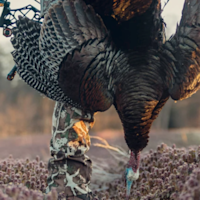
Almost as soon as the tom landed in the clearing, he gobbled and puffed up. After four days of getting beat by the birds, it was a surreal sight. It was even more surreal when he dropped out of strut and bee-lined it for the logging road I was positioned next two with my 20-gauge laid across my knee.
That suicidal two-year-old took me from a turkey hunter to a turkey killer. In the nearly three decades since that moment, there have been plenty of toms and jakes, but that one was special because he was my first.
If you are still looking to clear that first-tom hurdle, don’t lose hope. There are many ways to set yourself up for success this spring, but the first and most important is to scout.
Turkeys Now, Turkeys Soon
Flocks of hens are predictable, and where the ladies go, so do the boys. Hens have distinct feeding, traveling, and roosting patterns that don’t change much until they either get messed with or the weather warms up enough to offer them fresh food sources.
Until then, what they do today, they often do tomorrow. This means that if you want to know where turkeys should be when you hunt them in April, start watching them now. Just remember, it’s not enough to see some strutters in a field that are trying desperately to get a jump on breeding season.
Pay attention to exactly where they are in the field. Pay attention to how they walk into the field, and how they exit it. Pay attention to exactly when they feed in certain spots. If you glass turkeys enough or run trail cameras (do both), you’ll realize how tight of a schedule birds usually keep. It’s incredible, and prying into that regimented world is the first step to success.
The second is to get to know your weapon, really well.
Comfortable Range
Whether you want to take your first bird with a shotgun or archery tackle, understand what your effective range is on a turkey-sized target. Pattern your shotgun until you find a load that delivers enough BBs to ensure that if your bird crosses the magic distance line, he’s dead.
If you bowhunt, practice on a 3D turkey target, a lot. Get to know whether you’re more of a seven-yard shot kind of hunter, or maybe you can stretch it out farther. When a turkey does commit, you want the utmost confidence that it’s over when he gets into range. You do not want to be thinking about whether or not you can close the deal.
Make The First Hunt Count
Just like in the whitetail realm, first turkey hunts are your best bet. The more they get hunted on a specific property, or in a specific location on a property, the harder they are to kill as the spring progresses.
If you gather enough pre-season intel, you’ll see they are vulnerable in different locations at different times. Maybe the picked cornfield is the ticket because they fly down from the roost at sunrise and scratch away. But what if they tend to land in the middle of the field and aren’t really concentrated until they re-group and leave at mid-morning?
This means that sweet field-edge setup might allow you to see, and call to, plenty of birds. You just might not be able to get them to commit, which is likely in the early season when they are still flocked up. Maybe there is a logging road or two-track, they usually take to leave the field that concentrates their activity? While the field-edge spot might be more fun to hunt, the logging road offers far higher odds of killing. This is an important distinction because just like with whitetails, a lot of new hunters set up to see—not kill. Don’t be like them.
To fine-tune the art of picking high-odds ambush sites, take note when you start dialing in their patterns. Pay close attention to the things that might affect, and alter, their daily routine. Bright sunlight, versus cloudy or rainy weather will do it. Wind will shake things up. Where I live, ground fog around the swamps and wetlands will do it, too. Birds won’t walk through the haze but instead will fly over it to higher spots on the landscape where they can see. Use your observations to dial in multiple spots for your first hunt, so you have backup plans. Then choose wisely.
Trust Your Setup
Whether you’re shotgun hunting or bowhunting, trusting your setup is huge. Second-guessing decoy spreads and calling techniques has saved a pile of longbeards over the years. If you’re on the fence with either, think of it this way. The more scouting you do, the more likely you are to be in a spot where real birds expect to see some action.
Use a quarter-strut Jake decoy, a laydown hen, and maybe another hen or two. Call to your comfort level, whether that’s hitting the mouth calls pretty aggressively, or maybe staying a little more subdued with a slate call.
Then, give it time.
When you expect to be bombarded with strutters at first light, but they don’t show, it’s tough. Stick it out. Trust your setup, and let it work for you. If you’ve done your homework, and aren’t giving away your position, the birds will show up. When they do, you’ll suddenly go from turkey hunter to turkey killer, which is a pretty sweet feeling.






Conversation